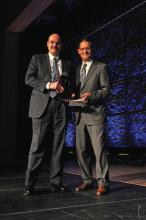
David Crawford on transit activity on the US's Pacific Coast
The US Pacific Coast is fast consolidating its position as the major North American investor in Bus Rapid Transit (BRT) implementation, with a total of 16 projects worth some US$2.3bn due to come into operation over the period 2010-2017.In California, theIn April 2011, SANDAG unveiled plans for a second project, Mid-City Rapid Bus, a high-frequency service with Traffic Signal Priority (TSP) and fare prepayment, that will pave the way for a full BRT link along the Downtown San Diego-San Diego University corridor, using the Compass Card regional for smart payment.
The San Francisco County Transportation Authority (SFCTA)'s US$118 million Van Ness BRT project is currently the subject of final environmental and preliminary engineering studies. Construction work on the conversion of one lane in either direction along Van Ness Avenue into a dedicated bus lane is due to start in 2013, with a revenue service becoming operational in 2014.
The scheme forms an integral element in a complete road safety overhaul of the north-south arterial, with BRT TSP being incorporated into a wide-scale array designed to reduce the level of traffic collisions. SFCTA expects it to decrease transit travel times by at least 18 per cent and increase person throughput by up to 12 per cent.
The
One of the most energetic agencies in the field is Washington State's King County (KC) Metro Transit, which serves Seattle, the county seat, Bellevue and over 20 suburban communities with its developing RapidRide service. KC Metro's first, A Line, BRT corridor went into operation in October 2010 along an 18km north-south route where it now provides a service at 10-minute intervals.
During 2011
The BRT programme is building on KC Metro's long record of activity in ITS development for transit. John Toone, who is ITS program manager in the agency's Metro Transit Division, told ITS International: "One way of quantifying the benefit of this to our BRT installation is that we are able to take on 24-32km of deployment each year for the next three years." By mid-2012, KC Metro plans to have installed a new Automated Vehicle Location (AVL) system based on a combination of GPS, dead-reckoning (compass plus odometer) and odometer tracking. Reporting will be via the agency's new 700MHz radio (long-range) and existing 4.9GHz wireless (short-range, where available) communications links. This will replace an existing roadside beacon-based system, in use for over 12 years, which is unable to continue tracking a bus that has gone off-route.
Early adopter
KC Metro is one of the first US transit agencies to have developed a TSP system, with its first deployment coming into operation in 2000 (prompting a site visit by the Los Angeles MTA (LAMTA) who wanted to learn more about it; LAMTA then developed its own closed-architecture TSP system using 802.11b wireless communications between the bus and the controller).Says Toone: "We used lessons learned from their project and then went the next step to a unified, open architecture ITS network."
TSP at 21 BRT intersections, using US National Transportation Communications for ITS Protocol Transit Communications Interface Profiles (NTCIP/TCIP) standards, is integrated into the buses' onboard systems, which "has significantly reduced development and deployment costs".
This integration allows for a high degree of control using 'conditional priority' to improve transit speed and reliability, on the basis of factors including location, direction of approach (from which approach is the bus entering the intersection), service route, scheduled trip, time of day, and green phase prediction.
Continues Toone: "Because our bus now knows a great deal about itself and what it's doing, the TSP message is very rich. When this is combined with other transportation management improvements, travel times can decrease by 10 per cent or more." Passengers, he adds, have asked KC Metro to give priority only to, for example, buses that are running late. "In practice we can but we don't use this as a criterion for requesting priority. We find that maintaining consistent travel times is more effective than making bus-by-bus value judgements."
Forming opinion
Late running and consequent bunching are, in any case, partly addressed by the countdown-style Real-Time Information System (RTIS), which is in operation at stops, and via the KC Metro website and through third-party apps (such as OneBusAway, initiated by students at the University of Washington). KC Metro uses this not just for passenger convenience but also as an active scheduling management tool for reducing loading times, for example."The availability of the information changes passenger behaviour in two ways: they are less likely to arrive extra early; and so less likely to get on the first bus they see," says Toone. "Arriving early and getting on the first bus has the effect of overloading a service, which then gets behind schedule; and continuing to overload it more and more the later it gets, to the point that the next trip catches up to it." The system's wireless network is integrated onto a fixed structure which provides a wireless bridge and a local wired network for a number of devices. This eliminates the need for modification to the signs to support wireless communication, reducing the amount of on-street physical infrastructure needed.
Vendors and consultants
• INIT (initusa.com):
onboard and central systems
• Vix ERG (vix-erg.com): electronic fare collection
• Motorola (motorola.com): 700MHz radio
• Eurotech (eurotech-ltd.co.uk): 4.9GHz mobile access router
• Cisco (cisco.com): fixed wired and wireless network equipment
• DKS Associates and GHz Communications (dksassociates.com / ghz-communications.com): network architecture and design
• ConSysTec (consystec.com):
ITS concept of operation
Fare payment Onboard fare payment is the norm on KC Metro, with 100 per cent deployment of smartcard readers. The A Line BRT corridor is the first route to have off-board payment and, says Toone: "We're still studying the benefits before going on to wider deployment." Offboard fare payment at all 26 BRT stations is supported by the same infrastructure as the RTIS, making the deployment of equipment a marginal cost by eliminating the need for a dedicated infrastructure (for example, a contract for wireless data service). Fare readers are in constant communication with the KC Metro back office infrastructure, enabling transactions to be processed immediately instead of through batch downloads. Updates can be carried out remotely.
Payment is via the One Regional Card for All (ORCA), installed by Vix ERG as a collaborative regional fare system for seven western Washington public transportation agencies in a four-county area. They include Community Transit, which operates the Swift BRT service along a 27km route.
Communications The BRT corridor deployment features a unified communication network with a 4.9GHz public safety band wireless network, which provides the Vehicle-to-Field (V2F) communication link of King County's ITS architecture. There is complete connectivity between the ITS Network and the King County WAN, providing Field-to-Centre (F2C) and Centre-to-Centre (C2C) ITS communications.
A future evolutionary step could see KC Metro making a move to 5.9GHz, which would involve upgrading 1,400 buses overall and over 100 access points. This would enable KC Metro to implement vehicle-to-vehicle communications, for example for road safety applications.
The KC Metro network represents an early deployment of the US Connected Vehicles (formerly IntelliDrive, formerly Vehicle Infrastructure Integration (VII)) initiative, which resulted in its formally being granted use of the US Department of Transportation IntelliDrive service mark (trademark). The concept aimed to enable safe, interoperable, networked wireless communications between vehicles, the infrastructure, and passengers' personal communications devices. USDOT has identified transit operations in particular as a key area for implementation.
The ITS network is the management responsibility of the King County Office of Information Resources, using existing network management tools and commercial-off-the-shelf equipment. The network is integrated into the King County WAN with connections to the Washington State Department of Transportation TrafficBuster network, providing C2C communications with all local cities taking part in the programme, including Seattle.
The last-mentioned is currently becoming active in developing its own ITS architecture.










